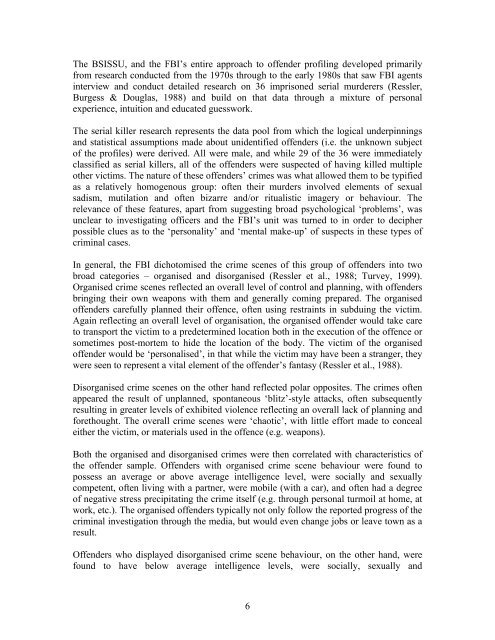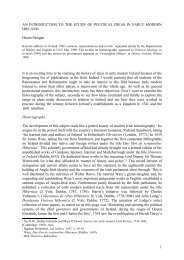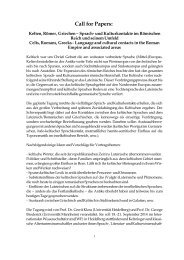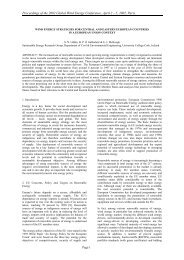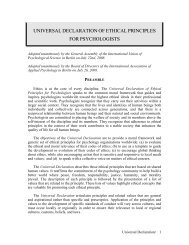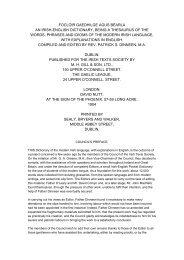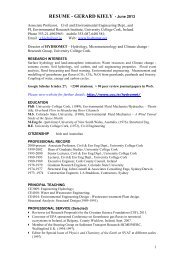Understanding Criminal Behaviour: Beyond Red Dragon - University ...
Understanding Criminal Behaviour: Beyond Red Dragon - University ...
Understanding Criminal Behaviour: Beyond Red Dragon - University ...
You also want an ePaper? Increase the reach of your titles
YUMPU automatically turns print PDFs into web optimized ePapers that Google loves.
The BSISSU, and the FBI’s entire approach to offender profiling developed primarily<br />
from research conducted from the 1970s through to the early 1980s that saw FBI agents<br />
interview and conduct detailed research on 36 imprisoned serial murderers (Ressler,<br />
Burgess & Douglas, 1988) and build on that data through a mixture of personal<br />
experience, intuition and educated guesswork.<br />
The serial killer research represents the data pool from which the logical underpinnings<br />
and statistical assumptions made about unidentified offenders (i.e. the unknown subject<br />
of the profiles) were derived. All were male, and while 29 of the 36 were immediately<br />
classified as serial killers, all of the offenders were suspected of having killed multiple<br />
other victims. The nature of these offenders’ crimes was what allowed them to be typified<br />
as a relatively homogenous group: often their murders involved elements of sexual<br />
sadism, mutilation and often bizarre and/or ritualistic imagery or behaviour. The<br />
relevance of these features, apart from suggesting broad psychological ‘problems’, was<br />
unclear to investigating officers and the FBI’s unit was turned to in order to decipher<br />
possible clues as to the ‘personality’ and ‘mental make-up’ of suspects in these types of<br />
criminal cases.<br />
In general, the FBI dichotomised the crime scenes of this group of offenders into two<br />
broad categories – organised and disorganised (Ressler et al., 1988; Turvey, 1999).<br />
Organised crime scenes reflected an overall level of control and planning, with offenders<br />
bringing their own weapons with them and generally coming prepared. The organised<br />
offenders carefully planned their offence, often using restraints in subduing the victim.<br />
Again reflecting an overall level of organisation, the organised offender would take care<br />
to transport the victim to a predetermined location both in the execution of the offence or<br />
sometimes post-mortem to hide the location of the body. The victim of the organised<br />
offender would be ‘personalised’, in that while the victim may have been a stranger, they<br />
were seen to represent a vital element of the offender’s fantasy (Ressler et al., 1988).<br />
Disorganised crime scenes on the other hand reflected polar opposites. The crimes often<br />
appeared the result of unplanned, spontaneous ‘blitz’-style attacks, often subsequently<br />
resulting in greater levels of exhibited violence reflecting an overall lack of planning and<br />
forethought. The overall crime scenes were ‘chaotic’, with little effort made to conceal<br />
either the victim, or materials used in the offence (e.g. weapons).<br />
Both the organised and disorganised crimes were then correlated with characteristics of<br />
the offender sample. Offenders with organised crime scene behaviour were found to<br />
possess an average or above average intelligence level, were socially and sexually<br />
competent, often living with a partner, were mobile (with a car), and often had a degree<br />
of negative stress precipitating the crime itself (e.g. through personal turmoil at home, at<br />
work, etc.). The organised offenders typically not only follow the reported progress of the<br />
criminal investigation through the media, but would even change jobs or leave town as a<br />
result.<br />
Offenders who displayed disorganised crime scene behaviour, on the other hand, were<br />
found to have below average intelligence levels, were socially, sexually and<br />
6


